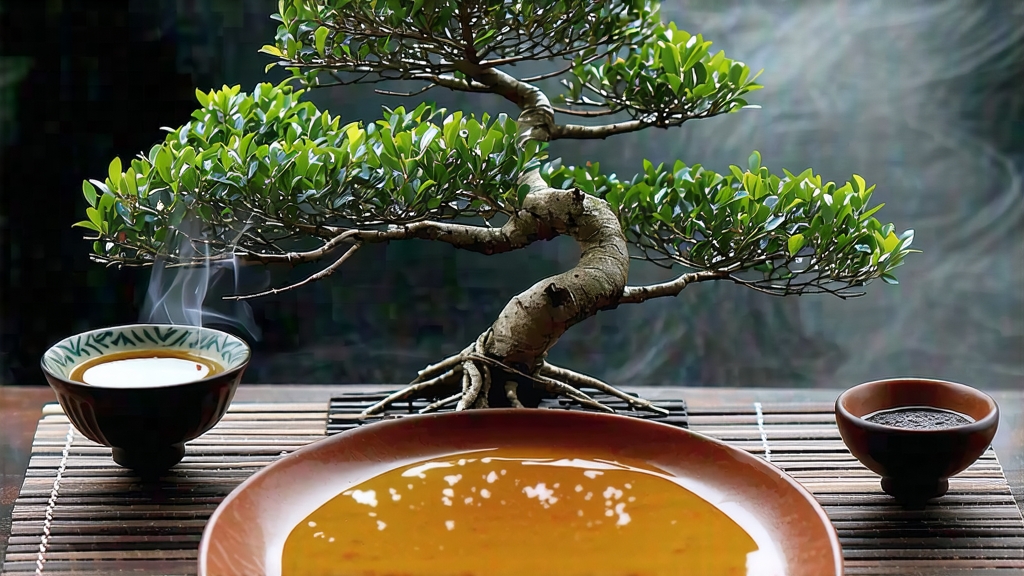
High in the mist-crowned Phoenix Mountains of Guangdong Province, rows of venerable tea trees cling to steep granite slopes, their roots braided into fissures that once fed volcanic soil. From these trees—some exceeding six centuries in age—comes Phoenix Dancong, an oolong family so perfumed that local farmers claim each bush can sing a different song of flowers and fruits. Unlike the blended teas of commerce, true Dancong is “single-tree” material: one plant, one harvest, one identity. In the West the name is still unfamiliar, yet for Chinese gongfu aficionados Dancong represents the summit of aromatic precision, a living library of scents captured in a cup.
Historical scrolls from the Song dynasty (960-1279 CE) already praise “Phoenix tribute tea,” but Dancong’s transformation into an oolong began during the late Ming, when refugees from the north brought with them the technique of partial oxidation. Mountain clans selectively bred wild tea populations, isolating individuals whose leaves naturally evoked litchi, jasmine, gardenia or almond. By the Qing, magistrates shipped these micro-lots down the Han River to the port of Shantou, where foreign merchants mistook the intense aromatics for added flavoring—an error that still shadows the tea abroad. Today the city of Chaozhou guards Dancong’s reputation with geographic-origin laws, restricting the label to leaves picked within 700–1,200 m elevation across Fenghuang (Phoenix) Town and neighboring valleys.
Botanically, Dancong belongs to the Camellia sinensis var. sinensis species, yet centuries of sexual reproduction have created hundreds of aromatic “fragrance types” (xiang xing). The most celebrated include Huangzhi Xiang (orange blossom), Milan Xiang (honey orchid), Zhilan Xiang (gardenia), Yulan Xiang (magnolia), and the legendary “Song Zhong,” a Song-era survivor whose leaves steep into a nectar reminiscent of dried longan and spice. Each tree is tagged, mapped, and registered; cuttings are never grafted, preserving genetic diversity. Thus every spring auction in Wudong Village becomes a botanical fashion show where buyers bid on the reputation of individual mother trees rather than on garden brands.
Crafting Dancong is a ten-step choreography balancing oxidation with fire. Picking occurs before Qingming when two leaves and a bud still wear their winter down. The pluck is withered under high-mountain sun until leaf edges curl like parchment, then moved onto bamboo trays for “water-walking,” an indoor withering that lasts through the night and reduces moisture to 60 %. The magic moment is shaking: armfuls of leaves are tossed in rattan baskets, bruising edge cells just enough to invite enzymes to the banquet. Masters listen for a rustle that sounds like distant rain on banana leaves—when that timbre arrives oxidation is halted by a 280 °C tumble in iron drums. Yet Dancong’s soul is forged in the charcoal bake. Using only lychee wood, the tea is baked, rested, and rebaked up to five cycles across two months. Between firings the leaves sleep on hemp cloth, absorbing ambient orchards and mountain mist, a process locals call “returning the mountain qi.”
To brew Dancong authentically one needs a tiny Chaozhou pot or three-piece gaiwan, softened water, and a willingness to coax. Pre-heat everything until too hot to touch, then fill the vessel one-third full with 5 g of long, wiry leaves. The first flash rinse is discarded with a swift wrist rotation that “wakes the phoenix.” Subsequent infusions start at 95 °C for barely five seconds, doubling the steep and dropping the temperature by two degrees each round. A well-roasted Dancong will yield twelve infusions: the early pours release top florals, mid-pours unveil tropical fruits, while later steeps descend into mineral depths that echo the granite parent rock. Throughout, the liquor remains a brilliant amber, so luminous that Chaozhou poets compare it to “a lantern hanging in a mountain cave.”
Tasting Dancong is olfactory archaeology. Swirl the first cup under your nose and hunt for the declared fragrance—say, honey orchid. If the aroma feels detached from the liquor, the bake was too shallow; if scorched sugar dominates, the charcoal was greedy. On the palate expect a